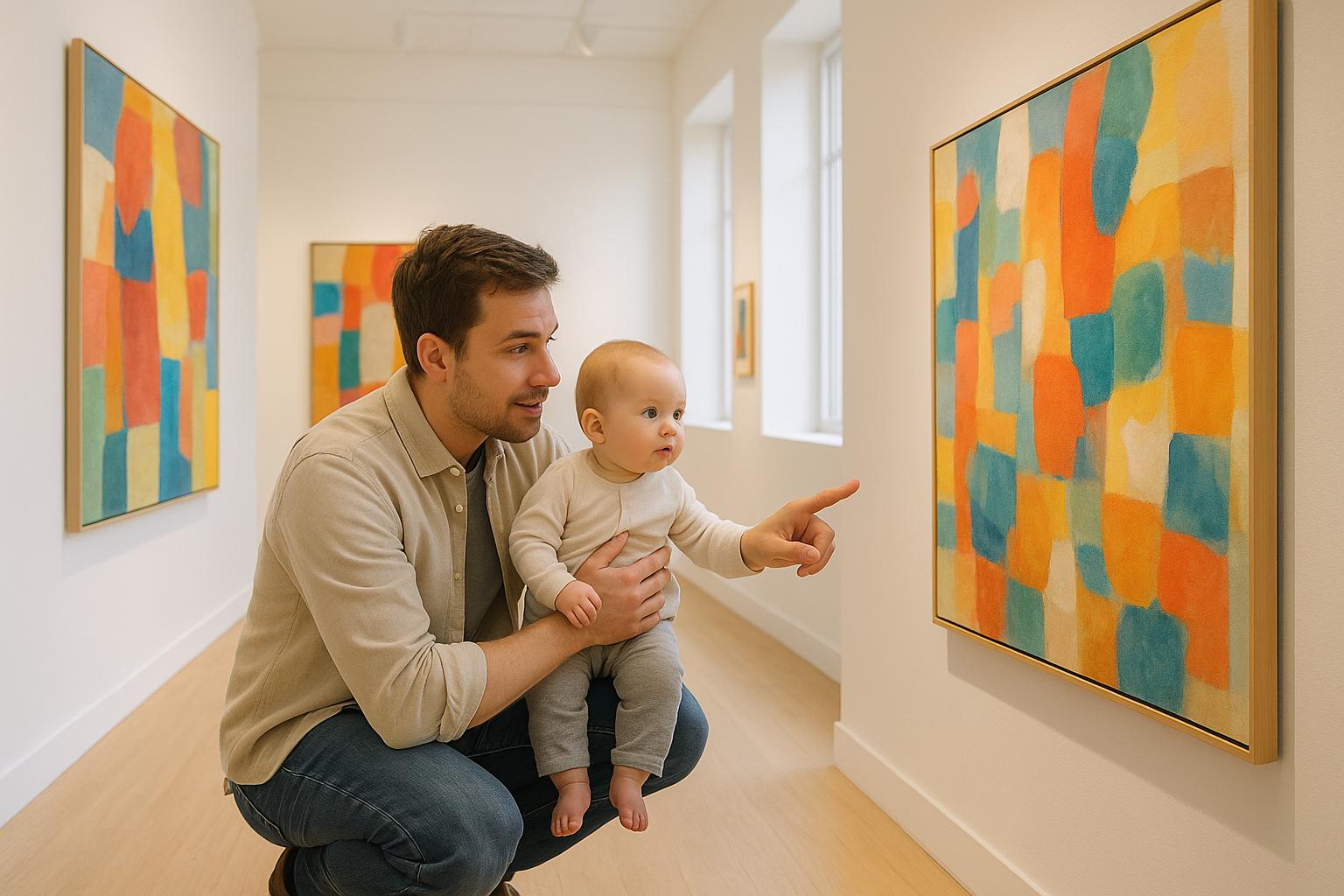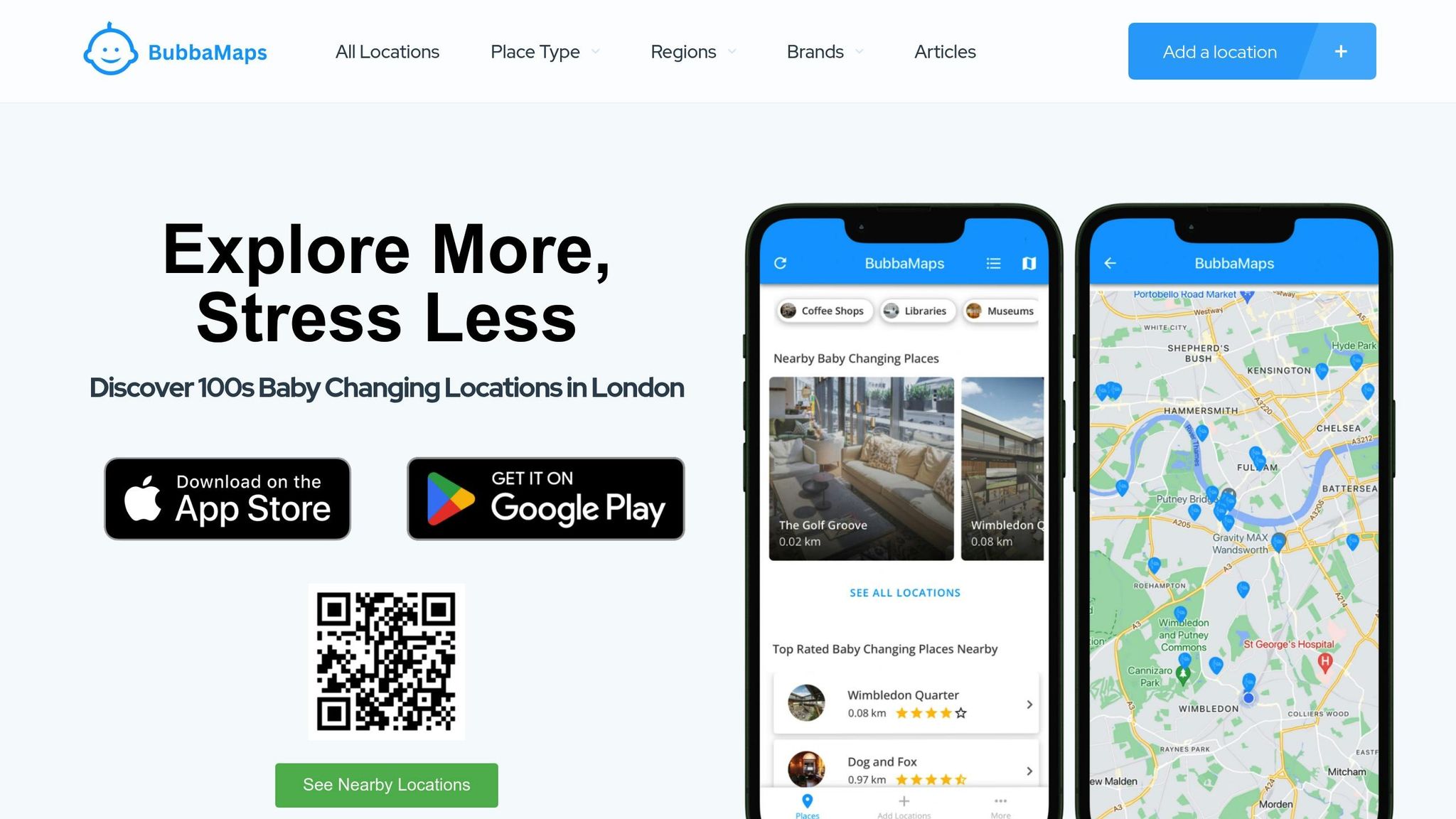
Art Galleries vs. Museums: Best for Babies
Exploring art galleries or museums with your baby can be a rewarding outing. Both offer sensory-rich experiences that support early development, but each has unique pros and cons. Here’s what you need to know:
- Art Galleries: Quieter, compact spaces ideal for shorter visits. They often feature bold artwork that captures a baby’s attention but may lack hands-on activities and extensive facilities.
- Museums: Larger venues with interactive exhibits and family-focused programs. They provide more baby-friendly amenities but can be crowded and overwhelming.
Key Tip: Use tools like BubbaMaps to plan your trip, ensuring access to clean changing areas, stroller-friendly routes, and feeding spaces.
Quick Comparison
| Factor | Art Galleries | Museums |
|---|---|---|
| Atmosphere | Quiet and serene | Busy and interactive |
| Facilities | Basic (e.g., changing tables) | Comprehensive (e.g., feeding rooms) |
| Activities | Limited | Interactive exhibits, family programs |
| Navigation | Easier due to smaller spaces | Can be challenging in large venues |
Choose based on your baby’s temperament, your preferences, and available amenities. Both options can offer a delightful first experience for your little one.
🎨 Discover the Best London Museums For A Family of 4! 🏛️
What Makes a Venue Baby-Friendly
A truly baby-friendly venue goes beyond just allowing strollers – it provides enough space, practical facilities, and a welcoming vibe that lets parents enjoy introducing their little ones to art and culture. The best venues offer thoughtful amenities that can transform what might be a stressful outing into an enjoyable and enriching experience for the whole family. Below, we’ll explore the key features that set these venues apart.
Essential Baby Facilities in Galleries and Museums
When it comes to baby-friendly spaces, certain features are non-negotiable: clean and well-maintained changing stations, step-free access, quiet feeding areas, and family-friendly cafes are at the top of the list. For instance, the Royal Academy offers a spacious, dedicated changing room, while the Design Museum provides accessible lifts and clear, easy-to-follow signage.
Step-free access is a game-changer for parents navigating with strollers. Venues like the Design Museum excel by offering well-thought-out layouts with elevators and ramps, ensuring that every area is easily reachable. Clear signage further simplifies the experience, helping parents quickly locate what they need.
Quiet feeding and changing areas are another must-have. These spaces provide privacy and comfort for nursing parents, as well as convenience for diaper changes. The Design Museum, for example, has a clean feeding room located in the basement, while the Science Museum features a spacious baby change area near the Pattern Pod, complete with a toilet and changing table. Some venues even offer secure buggy bays, which are especially helpful in crowded environments.
What really sets exceptional venues apart is their attention to a baby’s perspective. Whether your child is in a stroller, a sling, or being carried, these spaces ensure accessibility and sometimes even highlight baby-friendly art or resources to make the visit more engaging for families.
How BubbaMaps Simplifies Your Visit

Planning ahead can make all the difference, and that’s where BubbaMaps comes in. This handy tool maps over 100 verified baby-changing facilities across London, including many in museums and galleries. With BubbaMaps, you can scout out your destination before you even leave the house.
The platform offers user reviews and navigation tools, giving you real, parent-tested insights about each venue. Instead of showing up and hoping for the best, you’ll know exactly where to find clean, accessible facilities.
BubbaMaps’ mobile app, available for iOS and Android, makes it even easier to adjust plans on the go. If you need to find the nearest changing station or check accessibility options, the app provides clear directions to nearby facilities. Plus, its community-driven updates ensure that the information stays accurate and up to date.
Art Galleries: Pros and Cons for Baby Visits
Art galleries can offer a unique outing for families with babies, but they come with their own set of advantages and challenges. Like other baby-friendly spots in London, galleries vary in how well they cater to the needs of families with young children.
Why Art Galleries Work Well for Babies
Art galleries tend to provide a serene and quiet environment, making them a good fit for babies. Unlike the often noisy and crowded museums filled with interactive exhibits, galleries maintain a more tranquil atmosphere that can be calming for little ones.
The flexibility of gallery visits is another big plus. Unlike some venues that require you to follow a specific route, galleries allow you to explore at your own pace. This means you can tailor the visit to your baby’s schedule, with shorter trips of around 30–45 minutes often being ideal for young children.
Visually, galleries can be quite stimulating for babies. Bold shapes, vibrant colors, and high-contrast artwork naturally draw their attention, helping to support the development of their vision. Research even indicates that such rich sensory experiences can aid a baby’s cognitive and perceptual growth.
Some London galleries go the extra mile to make families feel welcome. For instance, the National Portrait Gallery offers sensory bags filled with items designed to make the experience more enjoyable and calming for parents and babies alike.
Additionally, gallery visits can provide a chance for parents to connect socially. This aspect is particularly important, as studies show that over 80% of new mothers experience feelings of loneliness during their baby’s first year.
Still, while galleries have plenty to offer, there are a few challenges to keep in mind.
Potential Drawbacks of Gallery Visits with Babies
One downside is the lack of hands-on activities. Unlike other family-friendly venues, galleries typically prohibit touching artwork, which can make it harder to engage a curious baby.
The formal environment of some galleries can also feel intimidating for parents. Concerns about strict rules or interactions with security staff may heighten stress, especially when dealing with a baby’s unpredictable behavior.
Facilities can also vary widely. While some galleries, like Dulwich Picture Gallery, offer amenities such as pram parking and basic changing facilities, these conveniences may come with trade-offs. For example, strollers often need to be left at the owner’s risk, which may not feel ideal for every parent.
Content is another consideration. Some historical artworks may feature unsettling or graphic themes that might not feel appropriate for a family outing.
Lastly, the physical demands of navigating a gallery with a baby can be tiring. On top of that, the pressure to keep your baby quiet – so as to avoid judgmental looks from other visitors – can turn what should be a relaxing cultural experience into a stressful one, focused more on managing behavior than enjoying the art.
Museums: Pros and Cons for Baby Visits
Museums provide a variety of facilities and interactive experiences that can be appealing for families with young children.
Why Museums Work Well for Babies
Museums go beyond basic baby-friendly amenities by offering sensory-focused and interactive exhibits that can engage even the youngest visitors. Studies suggest that museum visits can encourage early brain development, starting as early as 3 months old.
Many museums are well-equipped to accommodate families. For instance, the British Museum features a Families Desk, the Ford Centre with explorer backpacks and trails, multiple baby-changing stations, and dedicated feeding rooms. At Tate Modern, parents with strollers are welcomed with accessible entrances, baby-changing facilities, a Baby Care Room, and family-friendly dining options.
Interactive exhibits, hands-on programs, and guided tours designed specifically for young children are also common. Museums such as the Ashmolean, The Whitworth, and the Natural History Museum organize activities like art-making, singing, and storytelling that tie into their collections. These efforts aim to create a welcoming and inclusive space where parents can care for their babies while enjoying enriching experiences.
Potential Drawbacks of Museum Visits with Babies
While museums have much to offer, visiting with a baby isn’t without its challenges. The sheer size of many museums, with multiple floors and extensive collections, can make the experience tiring and time-consuming.
Crowds and noise can also complicate visits. Popular museums often attract large groups, school trips, and bustling interactive exhibits, which may overwhelm babies or disrupt their naps due to overstimulation.
Security measures can sometimes feel daunting for parents. Interactions with security staff or unclear rules may add stress, especially when juggling a baby. Additionally, structured museum programs may not always fit seamlessly into a baby’s unpredictable routine.
Another limitation is that many museum exhibits are tailored for older children or adults, leaving fewer meaningful activities for very young children. Parents might find it frustrating if exhibits fall short in addressing their baby’s needs. On top of that, navigating to find changing rooms, feeding areas, or quiet spaces can be stressful, particularly during moments when your baby is upset.
sbb-itb-a5e9dda
Art Galleries vs. Museums: Side-by-Side Comparison
Choosing between art galleries and museums for a family outing can feel like a balancing act. By understanding how they differ in size, facilities, and atmosphere, you can pick the venue that best suits your needs – especially if you’re bringing a baby along. While both offer enriching experiences, their unique characteristics can make one more suitable than the other depending on your situation.
Size and Navigation: Museums are often sprawling, bustling spaces that can be challenging to navigate with a stroller. For instance, the British Museum is known for its crowded halls and limited elevator access, making it less stroller-friendly. On the other hand, galleries tend to be smaller and more manageable, offering a cozier experience for families.
Facility Quality: When it comes to baby amenities, both museums and galleries are equipped to cater to families, but museums generally have the edge. They often provide a wider range of facilities, like those at the Science Museum or Tate Modern. However, galleries like the Royal Academy of Arts also prioritize family needs with reliable amenities designed to accommodate strollers.
Atmosphere: Museums often host interactive exhibits and attract larger crowds, which can be overstimulating for babies. In contrast, galleries provide a quieter and more relaxed setting, making them a calmer choice for younger visitors.
Comparison Chart: Galleries vs. Museums for Babies
| Factor | Art Galleries | Museums |
|---|---|---|
| Baby Changing Facilities | Dedicated and well-maintained (e.g., Royal Academy of Arts) | Comprehensive, family-focused amenities (e.g., Science Museum, Tate Modern) |
| Stroller Navigation | Easier due to compact spaces | Can be challenging in larger, busier venues (e.g., British Museum) |
| Baby-Friendly Programming | Less common | Regular activities and family sessions available |
| Staff Support | Often more personal and attentive | Includes specialized family services (e.g., British Museum Families Desk) |
Both galleries and museums contribute to your baby’s sensory and cognitive growth. However, museums may offer a broader range of experiences thanks to their diverse collections and interactive features.
For parents looking to simplify their planning, BubbaMaps is a game-changer. This community-driven platform verifies baby-friendly facilities at over 150 locations across London, including both galleries and museums. With BubbaMaps, you can easily find venues that meet your specific needs, ensuring a stress-free outing with your little one.
How to Plan a Successful Visit with Your Baby
Planning a baby-friendly outing in London takes some thoughtful preparation, but it can make all the difference in creating a smooth and enjoyable experience. Start by doing your homework, packing smartly, and scheduling your visit to align with your baby’s routine.
Research Before You Go
Before heading out, visit the websites of the galleries or museums you’re considering. Look for details on family-friendly amenities, opening hours, and any special programming for children. Many venues, like the National Portrait Gallery, offer helpful features such as a family lunchroom during school breaks and a kid-friendly menu in their café.
Check for stroller access, elevators, and any restrictions on buggies during busy periods. These small details can make navigating the space much easier.
Save yourself time and frustration by using tools like BubbaMaps. This platform provides up-to-date, community-driven reviews from other parents, helping you quickly identify venues with excellent baby-changing facilities and other parent-approved amenities. Combining BubbaMaps insights with information from venue websites ensures you’re fully prepared for your outing.
What to Bring for Your Baby
Once you’ve done your research, it’s time to pack the essentials. Bring along diapers, wipes, extra clothes, snacks, toys, and a comfort item to handle any surprises.
Don’t overlook feeding supplies. Even though many venues have cafés, they might not accommodate your baby’s specific dietary needs. Pack enough formula, baby food, or nursing supplies to last the entire trip, and plan for potential delays. Being prepared will save you from stressful situations.
Schedule Around Your Baby’s Routine
Timing is everything when it comes to a successful visit. Plan your outing around your baby’s nap and feeding schedule to keep them comfortable and happy. Instead of trying to see everything, focus on one or two key exhibits or areas.
It’s also a good idea to leave room for flexibility. Many venues allow re-entry, so you can take quick breaks or leave early if needed. Shorter, more frequent visits often work better than trying to pack everything into one long day.
With solid research, a well-packed bag, and a schedule that works for your baby, you’re ready to explore London’s cultural gems as a family.
Which Option Is Right for Your Family
Deciding between art galleries and museums really comes down to your baby’s personality, your family’s interests, and the amenities each venue offers. Both experiences can be enriching for your baby’s sensory and cognitive growth, but they shine in different ways.
Art galleries are perfect for families looking for shorter, more focused outings. Their vivid, high-contrast artwork often grabs the attention of little ones, and their compact layouts make navigating with a stroller much easier. Plus, the quieter atmosphere in many galleries can be a haven for babies who are sensitive to loud noises or bustling crowds.
On the other hand, museums bring variety and longer engagement to the table. Many museums cater specifically to families with babies, offering programs and spaces designed just for them. For instance, the Science Museum’s Pattern Pod includes areas tailored to small babies, complete with spacious changing facilities and exhibits that are just right for their age.
Interestingly, research has found that even babies as young as 4 months old can engage with art, and by 6 months, they can recall exciting experiences.
When making your decision, think about practical needs too. Tools like BubbaMaps can help you find venues with verified changing facilities and honest reviews from other parents, making your outing smoother and more enjoyable.
FAQs
What should I consider when choosing between an art gallery or a museum to visit with my baby?
When choosing between an art gallery and a museum for an outing with your baby, it’s worth weighing a few practical considerations. Museums often feature interactive exhibits and sensory-rich displays, which can capture a young child’s attention. Plus, many museums are designed with families in mind, offering conveniences like stroller-friendly layouts and baby-changing stations.
Art galleries, on the other hand, provide a visually engaging experience but may require more vigilance. The quieter atmosphere and proximity to delicate artwork mean you’ll need to keep a closer eye on your little one.
It’s also helpful to think about factors like noise levels, crowd sizes, and whether the venue has baby-friendly amenities such as nursing areas or accessible restrooms. The right choice will depend on your baby’s age, personality, and the specific accommodations available at the location you’re considering.
How does BubbaMaps make visiting art galleries and museums with a baby easier?
BubbaMaps takes the hassle out of outings with your baby by helping parents and caregivers easily locate verified baby changing facilities in art galleries and museums. With features like user reviews and built-in navigation, the app makes it simple to find clean, accessible spaces quickly, ensuring a more comfortable and stress-free visit.
Whether you’re admiring a new exhibit or spending quality time with your family, BubbaMaps keeps you ready for any diaper-changing moments, so you can focus on making memories with your little one.
What should parents look for to ensure a venue is baby-friendly?
When selecting a venue that’s suitable for babies, it’s important to focus on places with clean and roomy baby-changing facilities. These amenities are a must-have for keeping both parents and little ones comfortable during the visit. Museums or galleries that offer interactive or sensory zones tailored for young children can also make the outing more engaging and enjoyable for everyone.
Another critical factor is accessibility. Look for venues with wide pathways to accommodate strollers, elevators, and family-friendly rest areas. These thoughtful features can make your trip smoother and more relaxing, ensuring a hassle-free experience for you and your baby.














